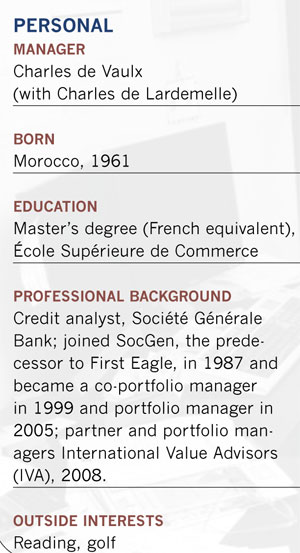He has also increased positions in insurance brokers Aon and Marsh & McLennan. As service businesses with almost no capital requirements, the companies should provide a good inflation hedge. Mastercard, which earns recurring revenues from fees for processing credit card transactions, should also benefit when inflation picks up.
During the summer, de Vaulx added to the fund's stake in the Washington Post Company, which declined when investors worried that a government crackdown on student loan programs would hurt the company's Kaplan unit. "With the stock so low, we were basically paying for the cable and newspaper operations and getting the Kaplan business for nothing," he says.
The fund has 14% of assets in Japanese companies, which he calls "by far the cheapest market in the world. Stocks there sell at 1.1 times book value, compared to 2 times book value in the U.S." He says that the cheapness of the market has less to do with the country's economy than the fact that companies are not managed with shareholder interests in mind. They do, however, have strong balance sheets and are sitting on a huge amount of cash.
"If you take that cash out of the equation, the adjusted price-earnings ratios are quite low," he says.
The fund's largest Japanese holding is Astellas Pharmaceuticals, which, like other pharmaceutical companies, has a product pipeline in need of replenishment. But Astellas has also made several reasonably priced acquisitions and has bought back a significant percentage of its shares. At a price of less than five times operating income, the stock "is considerably cheaper than Pfizer."
Because Japan now exports more goods to China than the U.S., he views companies there as a back-door entry point to that emerging market's growth. He avoids direct investment in Chinese companies because of their lack of transparency and the threat of government regulation. "It's a mistake to mechanically equate strong economic growth with good stock market performance," he observes.
As new fund inflows go largely toward stock market bargains, the bond portion of the portfolio has shrunk from 35% of assets at the middle of last year to its current level of about 20%. The bulk of the bond allocation is in former investment-grade bonds that became high-yield securities when tough times hit. To prevent a hit if inflation rears up in a couple of years, de Vaulx keeps maturities in the two-to-seven year range.
At 6.5% of assets, gold bullion represents the fund's largest position. The stake represents a form of insurance against both inflation and deflation, since gold prices tend to do well in both types of environments.









